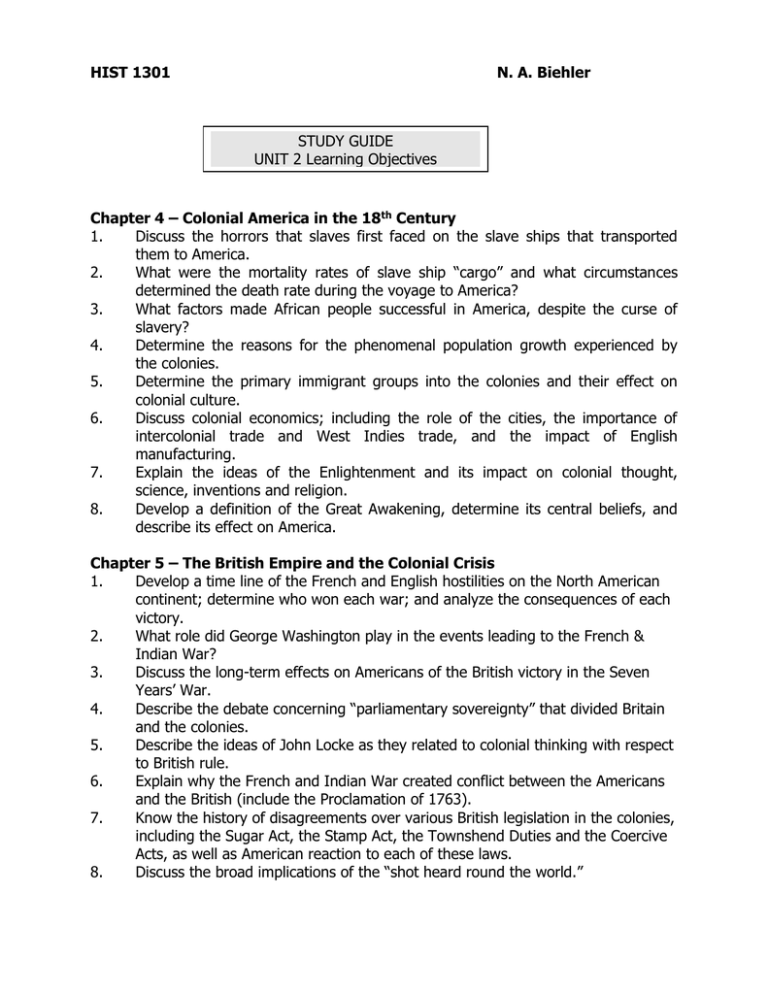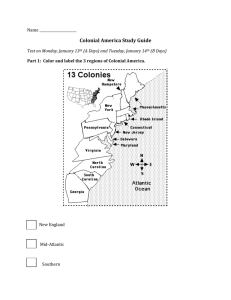HIST 1301 N. A. Biehler
advertisement

HIST 1301 N. A. Biehler STUDY GUIDE UNIT 2 Learning Objectives Chapter 4 – Colonial America in the 18th Century 1. Discuss the horrors that slaves first faced on the slave ships that transported them to America. 2. What were the mortality rates of slave ship “cargo” and what circumstances determined the death rate during the voyage to America? 3. What factors made African people successful in America, despite the curse of slavery? 4. Determine the reasons for the phenomenal population growth experienced by the colonies. 5. Determine the primary immigrant groups into the colonies and their effect on colonial culture. 6. Discuss colonial economics; including the role of the cities, the importance of intercolonial trade and West Indies trade, and the impact of English manufacturing. 7. Explain the ideas of the Enlightenment and its impact on colonial thought, science, inventions and religion. 8. Develop a definition of the Great Awakening, determine its central beliefs, and describe its effect on America. Chapter 5 – The British Empire and the Colonial Crisis 1. Develop a time line of the French and English hostilities on the North American continent; determine who won each war; and analyze the consequences of each victory. 2. What role did George Washington play in the events leading to the French & Indian War? 3. Discuss the long-term effects on Americans of the British victory in the Seven Years’ War. 4. Describe the debate concerning “parliamentary sovereignty” that divided Britain and the colonies. 5. Describe the ideas of John Locke as they related to colonial thinking with respect to British rule. 6. Explain why the French and Indian War created conflict between the Americans and the British (include the Proclamation of 1763). 7. Know the history of disagreements over various British legislation in the colonies, including the Sugar Act, the Stamp Act, the Townshend Duties and the Coercive Acts, as well as American reaction to each of these laws. 8. Discuss the broad implications of the “shot heard round the world.” Chapter 6 – The War for America 1775-1783 1. Explain how Thomas Paine presented Common Sense and made it such an effective tool in spurring the Revolutionary cause. 2. Examine the way British Government operated as opposed to American thinking on how governments SHOULD operate. 3. Describe the advantages/disadvantages of British and American forces in the American Revolution. 4. Discuss the significance of the Battles at Trenton and Princeton 5. Discuss the significance of the Battle of Saratoga 6. Discuss the significance of the Battle at Yorktown 7. Examine the effects of the war in America, i.e. impact on the population. 8. Explain the results of the Treaty of Paris of 1783. Chapter 7 – Building a Republic 1. Discuss the role of Republican motherhood, including why formal education for women became a priority after the Revolution. 2. How were the state governments a model for national government? 3. Discuss the strengths and weaknesses of the Articles of Confederation. 4. Identify the major problems of western settlement and evaluate the Articles of Confederation success in dealing with the problems, including the Land Ordinance of 1785. 5. Identify the reforms that were meant to abolish inequality in post-Revolutionary American society. 6. Discuss the political theory of Montequieu and Madison. What was the major conflict between the two men’s ideas? How did Madison solve the problem? 7. Explain the significance of Shay’s Rebellion. 8. Know the major components of the Virginia and New Jersey Plans, identify the major differences between the two, and analyze the compromises reached between the two plans. 9. Describe the conflict over slavery and the compromises reached on the issue in the Constitution. 10. Name the “Father of the Constitution.” 11. Understand the ratification controversy, including the viewpoints of the two sides and the issues which divided them. 12. Explain the victory achieved by the Anti-federalists in the struggle over the ratification of the Constitution.





